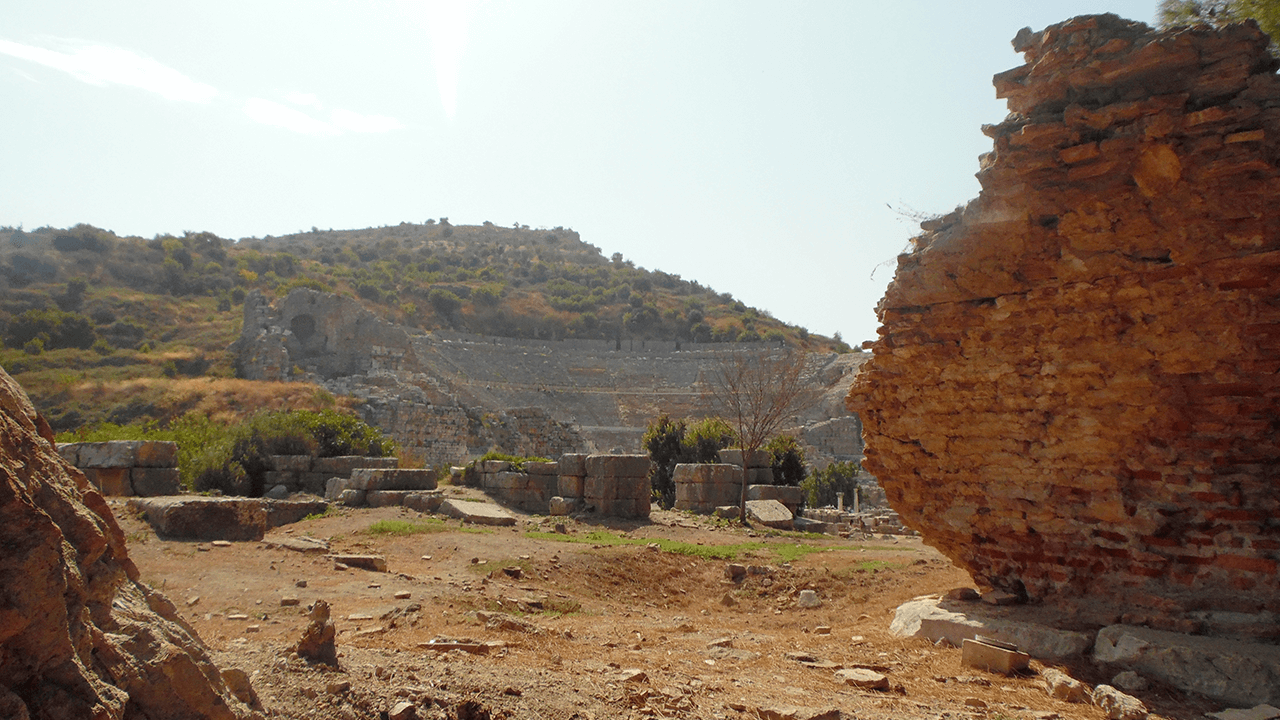The Vedius Gymnasium: A Center of Culture and Training in Ancient Ephesus
The Gymnasium of Vedius, located at the southern entrance of Ephesus, is one of the most impressive and well-preserved buildings of this ancient city. Built in the 2nd century AD by order of Publius Vedius Antoninus and his wife Flavia Papiana, this gymnasium was dedicated to the goddess Artemis and Emperor Antoninus Pius, two key figures in the lives of the Ephesians. This gymnasium became an important center for physical, artistic, and cultural education for the youth of the time.
History and Purpose of the Gymnasium of Vedius
In ancient Ephesus, gymnasiums were not just spaces for physical exercise but also centers of comprehensive education. Young men received training in art, sports, literature, theater, and public speaking, skills that prepared them for an active life in society. The Gymnasium of Vedius was undoubtedly the most prominent of these educational centers, renowned both for its beauty and cultural significance.
Dedication to Artemis and Antoninus Pius
The gymnasium was dedicated to the goddess Artemis, protector of Ephesus, and to Emperor Antoninus Pius, reflecting the connection between religion and political power in ancient Rome. This dedication serves as a reminder of the Ephesians’ devotion to their gods and leaders, who saw the construction of such spaces as a way to honor their deities and rulers.
Structure and Design of the Gymnasium of Vedius
The main entrance of the gymnasium is on the east side. Upon entering, visitors were greeted by a palaestra, or courtyard, surrounded by columns. This open area served as a space for exercise and socialization, where young men engaged in physical activities and outdoor training.
The Hall of Emperors
Also located on the east side of the gymnasium is the Hall of Emperors, a room decorated with statues and mosaic floors. This richly adorned space highlighted the influence of the Roman Empire on the city and celebrated the emperors who favored Ephesus. The presence of these statues and decorations is a testament to the cultural and political significance of the gymnasium.
The Bath Complex in the Gymnasium
The Gymnasium of Vedius included a bath complex, an essential feature in Roman gymnasiums. The bath contained the three typical sections of Roman baths: the tepidarium (warm room), the caldarium (hot room), and the frigidarium (cold room).
The Frigidarium and the Statue of Kaistros
In the frigidarium, the Ephesians could enjoy a cold-water pool, ideal for cooling down after exercise. At the northern end of this pool stood a statue of the River God Kaistros, depicted pouring water into the pool from an amphora. This statue, now on display at the Izmir Museum, added a decorative and symbolic element to the gymnasium, connecting the Ephesians with their natural environment and mythological beliefs.
Cultural and Educational Importance of the Gymnasium of Vedius
The Gymnasium of Vedius was much more than a place for physical training. Its design and functions demonstrate how gymnasiums in ancient Ephesus were places where both body and mind were nurtured. Through education in arts, sports, and literature, young Ephesians were prepared to play an active role in society, forming an educated and values-driven generation.
A Model of Holistic Education
The gymnasium served as a model of holistic education, combining physical activities with cultural learning. This approach made the Gymnasium of Vedius a complete and multifunctional space, standing out as one of the main educational centers in ancient Ephesus.
Tips for Visiting the Gymnasium of Vedius
- Location: The gymnasium is located at the southern entrance of Ephesus, making it one of the first points of interest for visitors entering from that direction.
- Recommended visiting time: It is advisable to visit early in the morning or at sunset to avoid the heat and make the most of the light to better appreciate the architectural details.
- Respect the site: As an archaeological site, it is important to respect the designated areas and avoid touching the structures to help preserve them.
Conclusion
The Gymnasium of Vedius is an architectural and cultural gem in ancient Ephesus, a place where young men were educated both physically and intellectually. Its design, decorations, and bath facilities reflect the importance of gymnasiums in Ephesian life, and its dedication to the goddess Artemis and Emperor Antoninus Pius underscores the connection between religion, politics, and education in the Roman era. Visiting the Gymnasium of Vedius offers a unique opportunity to delve into history and understand how generations were shaped in one of the most influential cities of the ancient world.


3 thoughts on “The Vedius Gymnasium”
★★★★★
Highly recommend visiting ‘The Vedius Gymnasium’—a site rich with history and unparalleled beauty.
★★★★★
Learning about and visiting ‘The Vedius Gymnasium’ was both fun and educational. Everyone should experience this!
★★★★★
Every moment spent at ‘The Vedius Gymnasium’ was filled with wonder and learning. It’s a place I will always cherish.